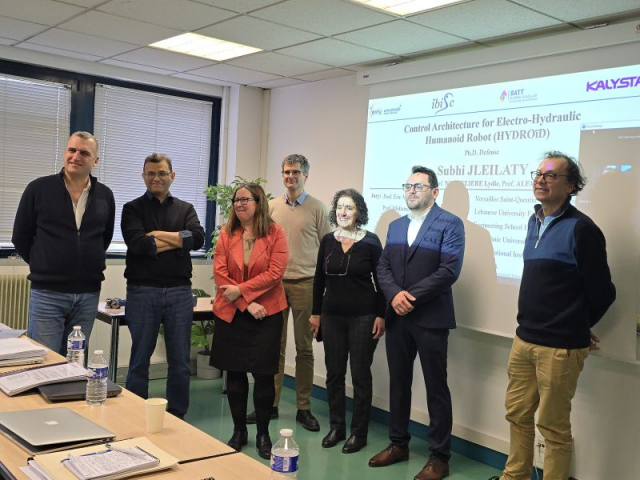Doctoral thesis jury composition
| Jujy member | Title | Institution | Role inside the jury |
|---|---|---|---|
| Lama AL BASSIT | Research Engineer | INRAE | Examinatrice |
| Samer ALFAYAD | Full professor | Université Paris-Saclay, Univ. Évry | Co-directeur de thèse |
| Antoine DEQUIDT | Assistant professor | Université Polytechnique Hauts-de-France | Examinateur |
| Mohamad KHALIL | Full professor | Université Libanaise | Rapporteur |
| Éric MONACELLI | Full professor | Université de Versailles Saint-Quentin-en-Yvelines | Examinateur |
| Lydie NOUVELIERE | Assistant professor | Université Paris-Saclay, Univ. Évry | Directrice de thèse |
| Thibaut RAHARIJAONA | Full professor | École Nationale d’Ingénieurs de Metz | Rapporteur |
Subhi JLEILATY defends his doctoral thesis on Tuesday February 20, 2024, 10:30 a.m. on the Pelvoux site, room Ax101.
Title: Control Architecture for electro-hydraulic humanoid robot (HYDROïD)
Abstract:
As the world of robotics continues to develop products with human-like capabilities, humanoid robots have seen remarkable expansion in real-world applications and industrial environments. Humanoid robots are intended to interact with humans, navigate, and work in human-friendly environments. Therefore, they must imitate not only the anthropomorphism, locomotion, manipulations, and behaviors of humans but also how humans manage them to achieve the highest degree of human emulation. Despite significant improvements in the control of these robots so far, they are still far from reliably exhibiting human-like behaviors. As part of this thesis, our research team patented (WO2020173933A1) and developed a servo-electrohydraulic actuator (SEHA). This hybrid actuator combines the advantages of electric and hydraulic technologies, attempting to address some fundamental challenges in the field. While SEHA facilitates mechanical design and actuation systems by replacing the central hydraulic pump with local electro-hydraulic actuators that integrate the hydraulic tubes and contribute to the robot’s dynamic movements, the control architecture is the key to managing these movements and determining the capabilities of the robot to improve its behavior. This thesis focuses on developing a SEHA-based humanoid control architecture that emulates the functionality of the human nervous system. Classical architectures deal with sensorimotor cycles but not with the distribution of intelligence. Whether centralized, where all components are connected to a central unit, or decentralized with very limited coordination between control units, or even distributed control system, which uses the units as an interface between I/O and the main controller without any ability to make a decision. The proposed solution is a real-time distributed control architecture. Joint controllers have the intelligence to make a decision, dominate the joint actuators, and inform the main controller of the joint status. Sensorimotor loops could be deployed in both the joint controller and the main controller. Real-time capabilities are provided in the main controller through the use of a real-time operating system (RTOS) alongside middleware operating a hard real-time communications system, accompanied by custom joint controllers operated by RTOS for embedded systems. The experimental validations were conducted on our electro-hydraulic humanoid robot (HYDROïD). The results demonstrated a 50% improvement in update rate compared to other humanoids and a 30% improvement in main processor and control task latency.
Main contributions of this thesis :
- SEHA-based humanoid control architecture: emulation of the human nervous system in intelligence distribution. It simplifies the reproduction of human movements by using measured biomedical data of human movements in its movement algorithms.
Mechatronic design of the control architecture: The research made it possible to identify and describe the specifications and constraints of the main components. - Experimental validation: Manufacturing controller prototypes for the SEHA actuator and its modules separately. Designed a graphical user interface for testing purposes.
- Demonstration: Control of the hip mechanism is present for a lower body walking experience of the HYDROïD with four DoFs.
- Date: Tuesday 20/02/2024, 10:30 am
- Location: Pelvoux site, room Ax101
- PhD student : Subhi JLEILATY (University of Evry, University of Paris Saclay, IBISC SIAM and IRA2 teams)
- Doctoral supervisor: Lydie NOUVELIERE (MCF HDR Univ. Évry, IBISC SIAM team)
- Thesis co-supervisor: Samer ALFAYAD (PR Univ. Évry, IBISC équipe IRA2)
- See the SATT Paris-Saclay SEHA 2019-2021 maturation project




